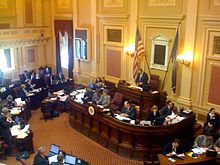Virginia State Senator
| Senate of Virginia | |
|---|---|
| Virginia General Assembly | |
 |
|
| Type | |
| Type | |
|
Term limits
|
None |
| History | |
|
New session started
|
January 13, 2016 |
| Leadership | |
|
Majority Leader
|
|
|
Minority Leader
|
|
| Structure | |
| Seats | 40 |
 |
|
|
Political groups
|
Majority
Minority
|
|
Length of term
|
4 years |
| Authority | Article IV, Virginia Constitution |
| Salary | $18,000/year + per diem |
| Elections | |
|
Last election
|
November 3, 2015 (40 seats) |
|
Next election
|
November 5, 2019 (40 seats) |
| Redistricting | Legislative Control |
| Meeting place | |
 |
|
| State Senate Chamber Virginia State Capitol Richmond, Virginia |
|
| Website | |
| Senate of Virginia | |
Coordinates: 37°32′20.3″N 77°26′1.7″W / 37.538972°N 77.433806°W
Majority
Minority
The Senate of Virginia is the upper house of the Virginia General Assembly. The Senate is composed of 40 Senators representing an equal number of single-member constituent districts. The Senate is presided over by the Lieutenant Governor of Virginia. Prior to the American War of Independence, the upper house of the General Assembly was represented by the Virginia Governor's Council, consisting of up to 12 executive counselors appointed by the Colonial Royal Governor as advisers and jurists.
The Lieutenant Governor presides daily over the Virginia Senate. In the Lieutenant Governor's absence, the President pro Tempore presides, usually a powerful member of the majority party. The Senate is equal with the House of Delegates, the lower chamber of the legislature, except that taxation bills must originate in the House, similar to the federal U.S. Congress. Members of the Virginia Senate are elected every four years by the voters of the 40 senatorial districts on the Tuesday succeeding the first Monday in November. The last election took place in November 2015. There are no term limits for Senators.
...
Wikipedia
